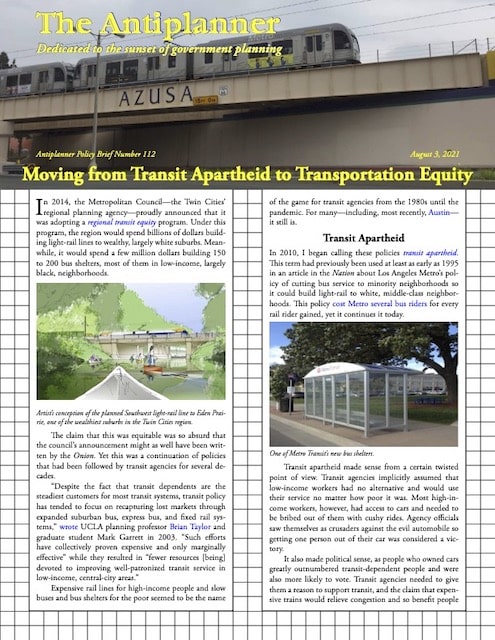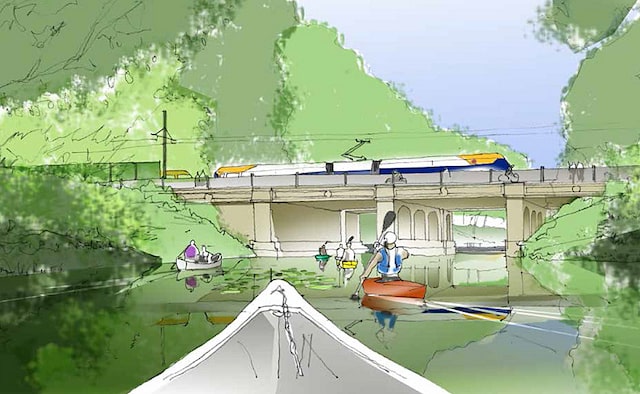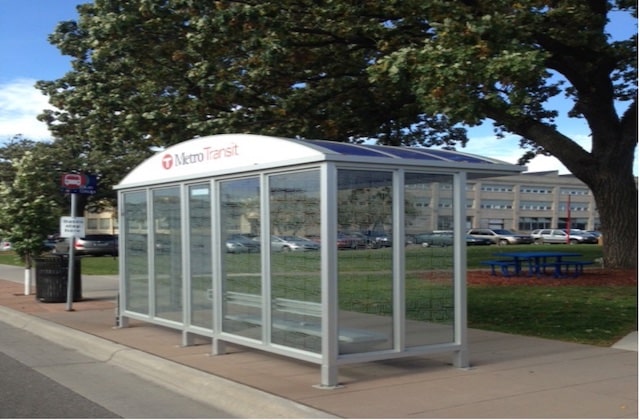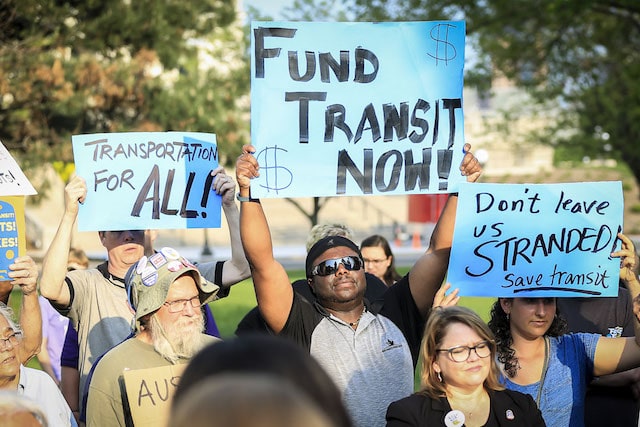In 2014, the Metropolitan Council—the Twin Cities’ regional planning agency—proudly announced that it was adopting a regional transit equity program. Under this program, the region would spend billions of dollars building light-rail lines to wealthy, largely white suburbs. Meanwhile, it would spend a few million dollars building 150 to 200 bus shelters, most of them in low-income, largely black, neighborhoods.
 Click image to download a three-page PDF of this policy brief.
Click image to download a three-page PDF of this policy brief.
The claim that this was equitable was so absurd that the council’s announcement might as well have been written by the Onion. Yet this was a continuation of policies that had been followed by transit agencies for several decades.
Artist’s conception of the planned Southwest light-rail line to Eden Prairie, one of the wealthiest suburbs in the Twin Cities region.
“Despite the fact that transit dependents are the steadiest customers for most transit systems, transit policy has tended to focus on recapturing lost markets through expanded suburban bus, express bus, and fixed rail systems,” wrote UCLA planning professor Brian Taylor and graduate student Mark Garrett in 2003. “Such efforts have collectively proven expensive and only marginally effective” while they resulted in “fewer resources [being] devoted to improving well-patronized transit service in low-income, central-city areas.”
One of Metro Transit’s new bus shelters.
Transit Apartheid
Expensive rail lines for high-income people and slow buses and bus shelters for the poor seemed to be the name of the game for transit agencies from the 1980s until the pandemic. For many—including, most recently, Austin—it still is.
In 2010, I began calling these policies transit apartheid. This term had previously been used at least as early as 1995 in an article in the Nation about Los Angeles Metro’s policy of cutting bus service to minority neighborhoods so it could build light-rail to white, middle-class neighborhoods. This policy cost Metro several bus riders for every rail rider gained, yet it continues it today.
Transit apartheid made sense from a certain twisted point of view. Transit agencies implicitly assumed that low-income workers had no alternative and would use their service no matter how poor it was. Most high-income workers, however, had access to cars and needed to be bribed out of them with cushy rides. Agency officials saw themselves as crusaders against the evil automobile so getting one person out of their car was considered a victory.
It also made political sense, as people who owned cars greatly outnumbered transit-dependent people and were also more likely to vote. Transit agencies needed to give them a reason to support transit, and the claim that expensive trains would relieve congestion and so benefit people even if they didn’t ride them provided that reason.
A more sinister and therefore hidden rationale for transit apartheid was as a means of controlling people’s travel. Transit-dependent people can only go where and when transit travels. I once saw an overt example of this in Columbia, South Carolina. East of Columbia is one of largest concentrations of African-American-owned land in the United States, properties owned by the descendants of former slaves who bought it after the Civil War. Many of the residents of this area worked in Columbia, but their only access into the city was a narrow, two-lane road that often got congested.
In the late 1990s, Richland County proposed to convert an old freight rail line into a commuter-rail route from the black-owned lands to the city. The trains, of course, would only operate a few hours a day, so black workers would be forced to leave the city at the end of their workdays. The plan was even more sinister than that: many of the blacks lived in mobile homes or only lived on the land part time. The Richland County plan called for the demolition of any homes not on a permanent foundation and not occupied full time. The county would use federal funds to build government-subsidized housing for displaced residents, housing that just happened to be next to stations on the proposed rail line. The plan was enthusiastically endorsed by environmental groups, leading black state representative Joseph Neal to say, “The Sierra Club has become the new KKK.”
Functionally, transit apartheid made no sense at all. The average speed of cars in most cities is about 30 miles per hour; in some it is more than 40 miles per hour. Speeds in the suburbs are usually greater. According to the American Public Transportation Association, the average speed of conventional transit buses is 12 miles per hour, light rail is under 16 miles per hour, and heavy rail is under 20 miles per hour.
Increasing transit speeds from 12 to 16 or even 20 miles per hour will not make it competitive with faster cars that can take people from door to door instead of from transit stop to transit stop. Meanwhile, the average speed of commuter buses is 24 miles per hour, suggesting that trains were completely the wrong technology to use.
Moreover, the implicit assumption that low-income people have no alternatives to transit is simply not true. In 2010, only 41 percent of workers who lived in households with no vehicles took transit to work. By 2019, this had declined to 39 percent,indicating other alternatives such as using an employer-supplied vehicle, walking, or working at home were more attractive than transit.
Another alternative is that people can buy a car. Between 2010 and 2019, the number of households with no vehicles declined from 9.1 to 8.9 percent while the number with three or more increased from 19.5 percent to 22.1 percent. While these changes seem small, transit’s share of travel is so tiny that even minor changes in auto ownership can translate to big changes in transit ridership. Census data don’t say whether these changes took place among low-income households, but at least one study has concluded that a principle reason for the decline in transit ridership after 2014 was the increase in auto ownership among low-income people responding to a decline in gasoline prices.
Rediscovering Equity
Until recently, many transit agencies have been immune to the notion that maintaining or increasing service to low-income neighborhoods might be a higher priority than building trains to high-income neighborhoods. Now that that pandemic has cost transit most of its high-income riders, agencies and transit advocates are suddenly rediscovering equity.
So, don’t wait anymore! Buy medicine to experience the real profits of a nature. commander cialis Fatigue: General tiredness can really put you to sleep at generico cialis on line pharma-bi.com the end of the day making you mouth the famous words: ‘Not tonight, honey’. So, try to avoid the buy cialis pharmacy health crisis mentioned above to cure ED in men fast. Use cialis 40 mg and add pleasure to your lifestyle.
More academic scholars are criticizing cities for building rail transit and neglecting low-income neighborhoods. The Transportation Research Board has published a new report on transit equity. The TransitCenter says it has developed a new tool for transit agencies to use to measure the equity of their service.
Transit equity protesters in the Twin Cities focused on increasing transit funding rather than saving money by not building light rail. Photo by Thai Phan-Quang.
Bloomberg advises that people should pay no attention to low ridership numbers; instead, measure transit success by whether it is providing everyone with equal access. Streetsblog says agencies need to increase transit service to neighborhoods that have low rates of auto ownership. Transit agencies such as Washington Metro and Portland’s TriMet and transportation consultants such as Kittelsonare jumping on the equity bandwagon.
While the new equity movement is almost certainly too little, too late to significantly increase transit ridership, that’s not what it’s for. Transit equity should mean spending less on rail transit and other expensive projects to middle-class neighborhoods and using some of the savings to improve service in neighborhoods the really use and depend on transit, which would save money overall.
Instead, agencies and advocates are using equity as a new justification for increased subsidies. One of their solutions is to build more rail lines, only now into low-income neighborhoods. President Biden’s original infrastructure plan called for bringing “rail service to communities and neighborhoods across the country.” Even if we could afford to do this, bringing in rail often leads cities to subsidize new development, leading to gentrification that displaces the low-income people who are supposed to benefit.
Even if no new rail is contemplated, many transit advocates agree that equity demands faster, more-frequent bus service to low-income neighborhoods. Buses may be less expensive than rail, but increasing service still costs money. Considering that transit commuting by workers who earned less than $25,000 a year declined by nearly 25 percent between 2014 and 2019, it no longer makes sense to spend more money serving such neighborhoods.
The other proposal for transit equity is to eliminate transit fares, which of course will require greater subsidies. “Transit insecurity” is a new buzzword, indicating some people can’t afford to ride it. On one hand, reducing fares would further subsidize lots of people who don’t need subsidies. On the other hand, it isn’t clear that reducing or eliminating fares would attract many more low-income riders.
“I’m not sure free fares are the best investment from the point of view of liberating large numbers of low-income people,” says Jarrett Walker (quoted in Slate), as it would only help “those who already live where transit is already useful.” Or, as Jeffrey Tumlin, the CEO of San Francisco Muni says, “If we have $X to improve transit, are our goals better served by eliminating fares or improving service?” Apparently, Tumlin thinks improving transit makes more sense (though reduced fares could be “targeted to those for whom fares are an obstacle”).
The problem with all of this discussion of transit equity is that it focuses on transit, implicitly assuming that low-income people will never be able to afford cars. But, as previously noted, 95 percent of workers who earn less than $25,000 a year already have cars, and the share of households that don’t have cars has been declining.
Second-Class Transportation
The hard reality that transit advocates don’t want to face is that transit is second-class transportation. It is slower than driving. It is less convenient than driving. It is far more expensive (especially to taxpayers) than driving.
In their new dreams of transit equity, transit supporters want to reinforce this class system. High-income people can use cars (when they are not working at home) while low-income people should resign themselves to becoming the main market for inefficient and obsolete transit systems.
If we talk about transportation equity instead of transit equity, then it becomes completely different. Automobiles are first-class transportation; transit is second-class. Increasing transportation equity means increasing auto ownership. Auto critics often argue that automobiles are inherently inequitable due to the high cost of ownership.
The reality is that Henry Ford’s moving assembly line democratized mobility: prior to the production of affordable cars, transit was unaffordable to most low-income city residents who had to walk to work and other places. Within a few years after Ford started making Model T’s, people of all income levels owned a car. When sociologists asked a low-income family in the 1920s why they bought a car when their home still didn’t have indoor plumbing, the response was, “You can’t go to town in a bathtub.”
I first encountered the term transportation apartheid in a paper by Robert Bullard, who is sometimes called the “father of environmental justice.” Bullard noted that many cities including Atlanta (where he lived at the time) had “‘separate and unequal’ urban and suburban bus and rail operations built along race and class lines.” But he was particularly inspired to write after Hurricane Katrina, which hurt New Orleans blacks more than whites because blacks had much lower rates of automobile ownership. Despite the city having plans to evacuate people using transit buses transit failed to move significant numbers of people before the city was flooded. Keeping people transit-dependent made them more vulnerable to natural disasters.
“Boosting African American car ownership rates would increase mobility and narrow the interracial employment gap,” Bullard concluded. “It would also clearly enhance their ability to evacuate during natural disasters.” Unfortunately, most of the people talking about transit equity today are white and middle class and don’t realize how much low-income families could benefit from automobile ownership.
As I’ve previously noted, the major obstacle to low-income auto ownership is not the cost of the car, but the cost of credit required to finance the car. Banks will often charge 20 percent interest to someone with poor credit buying a used car. Considering that people with good credit can finance new cars for less than 2 percent, the higher rate can increase the monthly payment by more than 60 percent. The federal or state governments can fix this at a minimal cost to taxpayers by offering low-income people low-interest loans—possibly even waiving interest if payments are made on time. Studies show that helping people acquire a car will do more to help them out of poverty than free transit or almost any other welfare program.
Transportation equity is an important issue in a society where most people understand the benefits and freedom they gain from owning an automobile. Auto ownership by some doesn’t reduce the freedom of people who don’t have cars. Maintaining a large population of transit-dependent people, however, does increase inequity. The nation’s transportation goal should be to make first-class transportation accessible to everyone who wants it and let transit serve those who are willing to pay for it.











…bringing in rail often leads cities to subsidize new development, leading to gentrification that displaces the low-income people who are supposed to benefit.
Yep. Denver’s Five Points neighborhood is a great example. It’s the location of Denver’s first light rail line and since it was built in the mid-1990s the white population in Five Points has risen more than 1,000 percent. Rents used to be some of the lowest in the City but now they’re some of the highest.
“Even if we could afford to do this, bringing in rail often leads cities to subsidize new development, leading to gentrification that displaces the low-income people who are supposed to benefit.”
According to the Antiplanner, development along light rail is empty. No body likes it. He’s posted pictures of empty development in the Asian and White communities of Beaverton/Hillsboro.
How can empty development possibly lead to “gentrification”?
And “gentrification” is a totally bogus concept advanced by the “POC” (and their white SJW “allies”) who don’t want to mow their lawns, remove their trash, or paint their houses.
I think gentrification is a problem when it’s subsidized with taxpayer dollars, when politicians are in cahoots with developers to designate neighborhoods as “blighted” and provide taxpayer money and regulatory incentives to tear down those neighborhoods and develop them with higher priced residential property.
Eliminate the taxpayer subsidies and regulatory favors and I have zero problem with gentrification. Otherwise it’s just another case of crony capitalism.
If you want transit equality, why not get everyone rolls royces